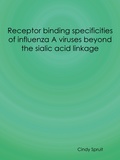Receptor binding specificities of influenza A viruses beyond the sialic acid linkage

Spruit, Cindy
- Promoter:
- Prof. dr G.J.P.H. (Geert-Jan) Boons
- Co-promoter:
- Dr R. (Robert) de Vries
- Research group:
- Vries
- Date:
- May 13, 2024
- Time:
- 16:15 h
Summary
Influenza A viruses are responsible for millions of deaths and cases of severe illness annually in humans and animals. New virus particles are produced inside cells and therefore the first step in the infection cycle involves influenza A virus particles binding to the cell surface. On the cell surface, the viruses bind to chains of sugar molecules (glycans). Glycans can vary a lot in, for example, the length, composition of sugar molecules in the chain, and connections between the sugar molecules.
The spread of influenza A viruses from birds, a species in which a lot of these viruses occur, to humans poses a big risk. Therefore, traditionally, a lot of studies have been performed on the transmission of these viruses from birds to humans. Influenza A viruses bind to sialic acids, a specific type of sugar molecule that is present on the end of glycan chains. The glycans in birds and humans are different because the sialic acids are linked differently to the rest of the glycan. In birds, the sialic acids are mostly α2,3-linked, while in humans the α2,6-linkage is most common, which poses a species barrier that may prevent virus transmission between species.
In this dissertation, we aimed to investigate the fine receptor specificities of IAVs and the molecular determinants responsible for this binding, looking beyond the classically considered α2,3-linked and α2,6-linked Neu5Ac. We aimed to investigate biologically relevant N-glycan cores presenting a diverse repertoire of epitopes, such as elongated branches, multiple branches, Neu5Ac, Neu5Gc, and sLeX epitopes.
In chapter 2, we genetically modified cells to present elongated glycans using the genes of the glycosyltransferases B3GNT2 and B4GALT1. We used these cells to investigate the binding and infection of contemporary human H3N2 influenza A viruses (IAVs) that use elongated glycans terminating in α2,6-linked N-acetylneuraminic acid (Neu5Ac) as their receptors. Flow cytometry analysis revealed that human H3 hemagglutinins (HAs) showed increased binding to the cells that presented elongated glycans. However, the increased number of elongated glycans on cells did not result in a greater infection efficiency of recent human H3N2 viruses. Therefore, we propose that H3N2 IAVs require a low number of suitable glycan receptors to infect cells and that an increase in the glycan receptor display above this threshold does not result in improved infection efficiency.
In chapter 3, we investigated the presence of N-glycolylneuraminic acid (Neu5Gc), α2,3-linked, and α2,6-linked Sias in animal models (mice, ferrets, guinea pigs, cotton rats, Syrian hamsters, tree shrews, domestic swine, and non-human primates) used to study human IAVs. We suggest using ferrets as animal models for human IAVs, since they closely resemble humans in the sialic acid content, both in the sialic acid linkages in different positions of the respiratory tract and the lack of Neu5Gc, lung organization, susceptibility, and disease pathogenesis. Additionally, we evaluated the role of Neu5Gc in infection using Neu5Gc binding viruses and CMAH -/- knockout mice and concluded that Neu5Gc is unlikely to be a decoy receptor.
In chapter 4, we then studied the molecular determinants for H7 and H15 IAVs binding to Neu5Gc using HAs from extinct highly pathogenic equine H7N7 viruses that exclusively bind Neu5Gc. The resolved crystal structure of the equine H7 HA in complex with Neu5Gc showed a high similarity with the receptor-binding site (RBS) of an avian H7 HA. In two distant avian H7 HAs and an H15 HA, we showed that mutation A135E is key for binding α2,3-linked Neu5Gc but does not abolish NeuAc binding. Additional mutations S128T, I130V, T189A, and K193R converted the specificity from NeuAc to Neu5Gc. Phylogenetic analysis revealed a clear distinction between equine and avian residues at positions 128, 130, 135, 189, and 193. The results provide insights into the adaptation of H7 viruses to Neu5Gc receptors.
In chapter 5, we investigated the influence of the five previously identified equine Neu5Gc-adapting mutations in avian H7 IAVs in vitro and in vivo. We showed that these mutations negatively affected virus replication in chicken cells, but not in duck cells, and positively affected replication in horse cells. Furthermore, the mutations reduced virus virulence and mortality in chickens but did not influence the low virulence of this virus in ducks. To explain why chickens and ducks were infected by these Neu5Gc-specific viruses despite the absence of Neu5Gc, we re-evaluated the receptor binding of H7 HAs. This showed that the mutated avian H7 HAs also bound to α2,3-linked NeuAc and sLeX epitopes, explaining why infection of ducks and chickens was possible. Interestingly, the α2,3-linked NeuAc and sLeX epitopes were only bound when presented on tri-antennary N-glycans.
In chapter 6, we showed that H5 HAs prefer to bind to tri-antennary N-glycan structures when compared to linear structures terminating in sLeX. Furthermore, some H5 HAs showed increased binding when the sLeX epitope was presented on an elongated MGAT4 arm, in contrast to an elongated MGAT5 arm. Additionally, we showed that sLeX epitopes are present on the trachea of several avian species, but not horses, pigs, and humans.